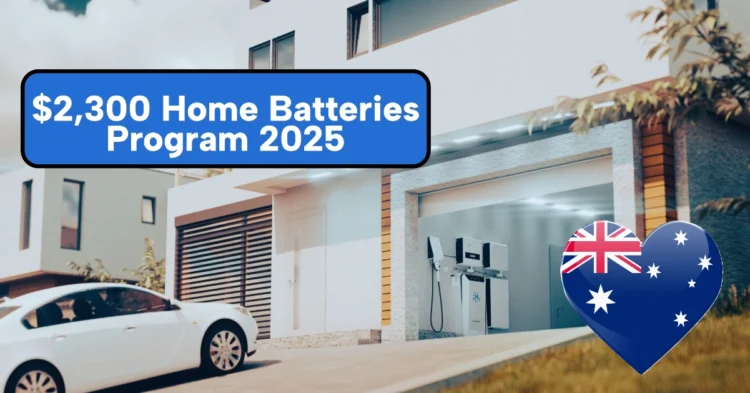The federal government has unveiled a bold new plan to deliver real cost-of-living relief for millions of Australians struggling under the weight of rising energy prices. If re-elected, the Labor government will roll out a $2.3 billion Cheaper Home Batteries Program, offering 30% off the upfront cost of a typical solar battery system—helping households, small businesses, and community facilities save up to $2,300 per year on their energy bills.
Table of Contents
Set to launch on July 1, 2025, this initiative marks a major step in making clean energy affordable and accessible—and it’s already being hailed as a “game-changer” for Australian families.
What Is the Cheaper Home Batteries Program?
The Cheaper Home Batteries Program is the government’s latest move to support Australians through the cost-of-living crisis while accelerating the transition to cleaner, renewable energy. The $2.3 billion scheme would subsidize the cost of home solar battery systems by 30%, which translates into a $4,000 discount on a standard battery.
Eligible participants include:
- Homeowners and renters
- Small businesses
- Community facilities
The plan is designed to support those who already have rooftop solar and want to add a battery, as well as those looking to install a brand-new solar and battery system.
$1,296.09 Centrelink Payment 2025: How to Apply, Eligibility, and Key Details
$400 Centrelink Bonus 2025: Who Gets It, When to Expect It, and How to Ensure You Receive It
How Much Could You Save?
Here’s what the government and energy experts estimate:
| Scenario | Estimated Annual Savings |
|---|---|
| Adding a battery to existing solar system | Up to $1,100 |
| Installing new solar + battery system | Up to $2,300 |
Energy Minister Chris Bowen said the savings would vary depending on usage and battery size but confirmed that the new system aims to dramatically reduce household reliance on the grid.
Why Solar Batteries Are a Smart Investment
Australia already leads the world in rooftop solar, with one in three homes fitted with solar panels. But only one in 40 households currently has a battery—a gap the government wants to close.
A solar battery system stores the excess electricity your solar panels generate during the day, allowing you to use that power at night or during peak hours. This:
- Cuts your energy bills
- Lowers grid demand during peak periods
- Makes your home more energy independent
- Reduces your carbon footprint
Real Aussie Families Are Already Saving Thousands
Adelaide dad Ryan Parsons is one of many Australians proving that home battery systems can be a game-changer. After investing $9,500 in solar panels and a further $14,000 in a BYD battery (after rebate), he has completely eliminated his family’s $2,000/year power bill.
“We were completely powered by our solar and battery for most of the year,” Ryan told Yahoo Finance. “It was a no-brainer. The solar paid itself off in two years, and the battery will in seven. We haven’t paid a power bill in nearly two years.”
How Will the Solar Battery Subsidy Work?
The program will:
- Begin July 1, 2025
- Be available for one battery system per household
- Support systems between 5 kWh to 50 kWh, with total support capped at 100 kWh
- Adjust pricing and eligibility annually, based on uptake and cost trends
The government has emphasized that the scheme is about ensuring affordable access to clean energy, and not just for the wealthy.
Why the Timing Matters
The government’s program comes as energy prices continue to rise, with many families feeling the squeeze. As part of its broader affordability agenda, the government is also extending its energy rebate program, providing two additional $75 quarterly installments starting July 1.
“This is good for power bills and good for the environment,” said Prime Minister Anthony Albanese.
Energy Minister Bowen added, “The contrast is clear—a re-elected Albanese government will lower household bills. Peter Dutton’s Liberals, on the other hand, want to spend $600 billion on nuclear power, which will drive bills up.”
Will There Be Means Testing?
While Labor’s current plan does not include income testing, there is speculation that the Liberal opposition may propose a means-tested battery rebate in the lead-up to the election. Policy details from the Opposition are expected soon.
The Bottom Line: Is a Battery Worth It?
If you’re considering a solar battery system, the Cheaper Home Batteries Program 2025 could be your opportunity to invest at a much lower upfront cost—and start saving right away.
Here’s why it might be a smart move:
- Payback period of 7–10 years, often shorter with subsidies
- Reduced or eliminated power bills
- Energy security and independence
- Contribution to a cleaner, more sustainable future
Next Steps for Households
To prepare for the upcoming subsidy:
- Audit your current energy usage
- Get quotes for solar and battery systems
- Monitor policy updates ahead of the July 2025 launch
- Talk to a certified installer about eligibility and system options
- Plan for grid feed-in agreements with your electricity provider
Want a personalized solar battery savings calculator, or a breakdown of which battery brands qualify for the program? Just let me know—I can help create custom resources for your needs or website!


One thought on “Cheaper Home Batteries Program 2025: How Australians Can Slash Energy Bills by $2,300 with New Solar Battery Subsidy”